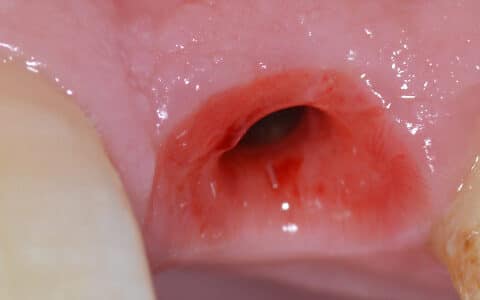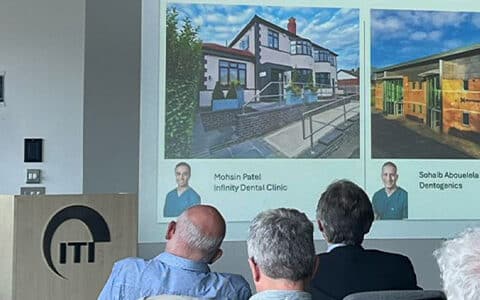In this blog I describe how we replace 4 failing teeth for this patient with 3 dental implants and a 4 unit implant bridge.
This patient presented to our clinic with a failing bridge in the upper left hand side of her mouth. As you can see from her pre-operative pictures, the bridge had been temporarily ‘glued’ together as a last ditched attempt for the patient to retain her smile. Obviously losing her front 4 teeth would have disasterous consequences for her confidence and also her function.
We planned to help our patient by replacing the 4 unit failing bridge with 3 dental implants and a 4 unit bridge. The treatment was planned meticulously using our 3-d CBCT scanner and planning protocol. We planned the full treatment prior to even removing any of the teeth. This ensured that the patient would ultimately recieve her treatment as efficiently and predictably as possible once we started.
As soon as the failing teeth were removed, we placed the 3 dental implants into the carefully planned positions of the UL2, UL4 and UL5 sites. This was done alongside the provision of bone grafting and gum grafting. The gum grafting in particular is a key part of this treatment, it enabled us to restore the gingival margins to the desired horizontal level so that each tooth looked evenly matched to each other. In other words, it prevents one tooth from looking too long relative to the adjacent teeth. The gum grafting also provides a stable foundation for long term implant success – minimising the risk of future gum recession in that part of the mouth.
Once the implants were placed a temporary bridge was provided to the patient so that she could continue to smile and live her life whilst osseointegration occured. This is the term given to the biological process of fusion between the dental implant surface and the patient’s own bone. This takes on average 3 months to occur before we can safely place the final implant supported restorations onto the implants themselves.
The manufacturing of the final implant teeth occurs via a carefully planned protocol. We design the teeth using digital technology that enables our team of technicians to design customised teeth which fit into the patient’s mouth in the most ‘natural’ way possible. Each individual tooth is adapted to fit into the patient’s own smile. Anatomical parameters are respected to ensure that these teeth do not look out of place when situated next to the patient’s own teeth.
The video below shows the meticulous planning that our technical team pursue to design this bespoke restoration of 4 teeth for our patient.
Our technical team is led by Sohaib and Mo and they are dedicated to providing patient’s with individual teeth. No two smiles ever look the same! Once we have collaborated together with our patient, we then begin the milling process to manufacture the restorations as per the agreed design. The milling occurs using CAD/CAM technology and precision milling of Zirconia to ensure we provide our patients with the strongest and most aesthetic type of dental restorations possible using the latest technology.
Following milling of the restorations, the teeth are carefully sculpted by the dental technicians to add individual detail and character to each tooth. This stage is extremely important to ensure that the teeth look ‘real’ – or at least as real as possible. Following this process, the restorations are then placed into the zirconia sintering machine to complete the manufacturing process and ‘set’ the prostheses into it’s final state. After this stage the restorations are now finished off and polished prior to being fitted into our patient’s mouth.
The teeth are screwed directly into the 3 dental implants and due to the precision milling and manufacturing process, this stage is possibly the most simplest part in the whole treatment journey of 3 months. Simply ‘screwing’ the teeth into the dental implants is a very simple task for me when everything preceeding this stage has been completed to the highest standard. From the planning of the surgery, to the accurate placement of the dental implants and then finally to the manufacturing process using digital technology.
Having placed over 5000 dental implants in my career thus far, I find that the simplest part of the treatment is fitting the final restorations. At our clinic we use the latest digital technology and planning protocol to ensure all of our restorations are made to the highest standards. It is for this reason we find the fitting of our restorations to be the most easiest and stress free part of the whole treatment journey. Our patient’s would agree with this too. Time spent planning is time saved in surgery and we are very proud to make our patient’s treatment journey as stress free as possible by utilising the latest standards in digital dental technology.
Thank you for reading,
Mohsin Patel
Related articles...
Book a Consultation
At Infinity Dental Clinic we see patients for routine dental check-ups with our dentists. Regular dental maintenance and good oral hygiene will ensure that you keep your teeth and gums healthy.
Book a Consultation













